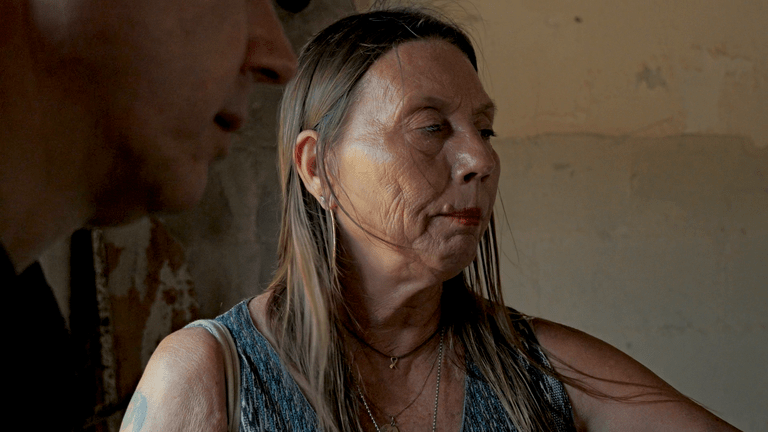The Lasting Impact of October 7: A Tale of Two Lives Torn Apart
On October 7, 2023, the small kibbutz of Nir Oz, located just a stone’s throw from the Gaza border, became the epicenter of a tragedy that would forever alter the lives of its residents. The day marked a brutal incursion by Hamas fighters, resulting in the deaths and kidnappings of many, including elderly residents who had dedicated their lives to fostering peace. This article explores the profound emotional and physical scars left on the community through the eyes of Rita Lifshitz, a resident of Nir Oz, and Sabah, a displaced Gazan.
A Community in Mourning
Rita Lifshitz has made it a ritual to return to her father-in-law Oded‘s home every week since that fateful day. “For 500 days, I came to have a beer outside the table,” she recalls, her gaze fixed on the patio where they once shared laughter and stories. The kibbutz, once a vibrant community, now stands as a haunting reminder of violence and loss. “It is a trauma,” Rita states, emphasizing that the entire kibbutz wakes up every morning to the memories of October 7.
The attack on Nir Oz was unprecedented in its brutality. Over 117 residents-more than a quarter of the kibbutz’s population-were either killed or taken hostage. Among them were Oded and his wife, Yocheved, both in their 80s and known for their charitable work promoting peaceful relations with Gazans. While Yocheved was eventually released after 16 days, Oded’s fate was far grimmer; he died in captivity, his body returned only a year later.
The Physical and Emotional Toll
As Rita walks through the remnants of her community, she points out the places where friends were murdered and loved ones taken hostage. The charred remains of homes serve as a stark backdrop to her memories. “They started firing rockets at us at 6:30 in the morning, but we didn’t worry because they have been firing rockets at us for 20 years,” she explains. The residents had grown accustomed to the sound of sirens and the threat of violence, but nothing could prepare them for the onslaught that day.
The sheer scale of the attack was staggering. Approximately 540 Hamas fighters overwhelmed the kibbutz, a number that far exceeded the local population. Only six homes escaped the devastation, while schools and community centers were left in ruins. The nursery school, once a place of laughter and learning, was reduced to ashes.
The Scars of Trauma
Walking through the kibbutz, Rita encounters the remnants of her friends’ lives. A black flag outside a house signifies a death, while a yellow flag indicates a hostage situation. “This is the death road,” she says, pointing to a street where nearly every house bears a flag. The emotional weight of these symbols is palpable, a constant reminder of the community’s collective grief.
In one home, the belongings of a murdered friend remain scattered, a haunting testament to the violence that erupted. Rita insists that the world must see these remnants, as they encapsulate the horror experienced by the residents of Nir Oz.
A Parallel Story: Sabah’s Struggles in Gaza
Just a few miles away, in Gaza, another story unfolds. Sabah, a resident of Khan Younis, has been displaced 13 times since October 7. Her home, once a sanctuary for her family, has been reduced to rubble. “I long to go back to even the ruins of my house, to sit among the rubble, simply to be there,” she laments. For Sabah, the loss of her home is not just a physical displacement but a deep emotional wound.
Sabah’s narrative is intertwined with the broader historical context of the Israeli-Palestinian conflict. “This goes back generations,” she explains, emphasizing that the events of October 7 are not isolated incidents but part of a long history of struggle and oppression. “We have lived our entire lives under this weight,” she adds, highlighting the generational trauma that has shaped her identity.
The Broader Implications
The stories of Rita and Sabah illustrate the complex and often painful realities faced by individuals on both sides of the conflict. While Rita grapples with the immediate aftermath of violence, Sabah’s experience reflects the long-standing grievances of the Palestinian people. “October 7 was just one day, but for us, it has felt like living through hundreds of October 7ths, over and over again,” she states, capturing the cyclical nature of suffering in the region.
The emotional scars left by the conflict are not easily healed. Rita’s weekly ritual of visiting her father-in-law’s home serves as both a tribute to the past and a reminder of the ongoing struggle for peace. Meanwhile, Sabah’s longing for her home underscores the deep-rooted desire for stability and security that transcends borders.
Conclusion
The events of October 7, 2023, have left an indelible mark on the lives of those in Nir Oz and Gaza. Through the stories of Rita Lifshitz and Sabah, we gain insight into the profound emotional and physical toll of conflict. As both communities navigate their grief and loss, the need for understanding and reconciliation becomes ever more urgent. The scars of trauma may fade, but the memories of that day will linger, shaping the future for generations to come.










